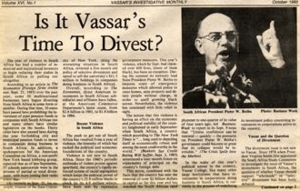Disinvestment from South Africa facts for kids

Disinvestment from South Africa was a big movement that started in the 1960s. People around the world wanted to stop apartheid, which was a cruel system of racial separation in South Africa. They did this by asking companies and countries to stop investing money in South Africa. This idea became very strong in the mid-1980s. A special law passed in the United States in 1986 helped put a lot of pressure on the South African government. This pressure played a key part in making them talk about ending apartheid, which finally led to its downfall.
Contents
- How the United Nations Helped
- The United States Joins the Fight (1977–1989)
- How This Affected South Africa
- See also
- Images for kids
How the United Nations Helped
The United Nations General Assembly (UN) is like a big meeting of countries. In November 1962, they passed a resolution, which is like a strong suggestion. This resolution created the United Nations Special Committee against Apartheid. It also asked countries to stop trading and doing business with South Africa. This is called imposing economic sanctions. However, many powerful Western countries that traded a lot with South Africa did not agree with this idea. They even refused to join the committee.
After this, a group in the UK called the Anti-Apartheid Movement (AAM) organized a big meeting in London in 1964. This meeting was about how economic sanctions could work. They wanted to show that stopping trade with South Africa was possible and fair. The meeting also showed that for sanctions to really work, big countries like Britain and the U.S. needed to join in. These two countries were the main ones holding back.
UN Embargos Against South Africa
An embargo is like a ban on trade. In 1977, the UN made its ban on selling weapons to South Africa mandatory. This meant all countries had to stop selling weapons. Later, in 1987, the UN also suggested a worldwide ban on selling oil to South Africa. This was a voluntary ban, meaning countries could choose to follow it.
The United States Joins the Fight (1977–1989)
When activists in the U.S. saw that their government wasn't stopping trade with South Africa, they found another way. They started asking individual businesses and investors to stop their money ties with South Africa. This was seen as a matter of being a good and responsible company. Many religious groups and even famous people like singer Paul Simon joined this effort.
The Sullivan Principles (1977)
One important part of this campaign was called the Sullivan Principles. These rules were created by Rev. Dr. Leon Sullivan, an African-American preacher. He was also on the board of General Motors, a huge car company. At that time, General Motors employed the most black people in South Africa.
The Sullivan Principles said that companies doing business in South Africa must treat all their employees equally, no matter their race. They also said that workplaces should be integrated, meaning people of all races work together. These rules went directly against the apartheid laws, which forced racial discrimination and separation.
Activists pushed businesses to follow these principles. They also asked big investors, like public pension funds, to take their money out of companies that did not follow the Sullivan Principles. This put a lot of financial pressure on companies.
More People Join the Movement (1984–1989)
The movement to stop investing in South Africa had been going on for 20 years. But it really grew after black South Africans strongly protested against a new constitution in 1983. This new law made racial separation even stronger.
People in South Africa started to resist the government in big ways. Many black local officials quit their jobs. The government declared a "State of Emergency" in 1985 and used many soldiers to stop the protests. News channels around the world showed these protests and the harsh police response almost every night.
Because so many people saw what was happening on TV, more and more countries and groups around the world decided to act. This led to a huge increase in efforts to isolate South Africa. These actions, combined with the protests inside South Africa, forced big changes in South Africa's economic relationships with other countries.
Universities and Colleges Take Action
Students in the U.S. played a big role. They demanded that their colleges and universities stop investing in companies that did business in South Africa. They put pressure on their school leaders. For example, in 1980, future U.S. president Barack Obama was a student at Occidental College and joined these activists.
Student protests became very strong in 1984 because of the TV news coverage. Over the next few years, more and more schools stopped investing in South Africa.
| 1984 | 1987 | 1988 | |
|---|---|---|---|
| Schools that stopped investing | 53 | 128 | 155 |
Michigan State University
The student movement started at Michigan State University and Stanford University in 1977. Michigan State University, Columbia University, and the University of Wisconsin–Madison had early success in 1978. After Michigan State stopped investing in 1978, the state of Michigan even tried to make all public colleges stop investing.
Columbia University
At Columbia University, students started a campaign in 1977. They protested against the university's investments in companies linked to South Africa. Students held many meetings and demonstrations. In May 1978, they even took over a building at the university. As a result, Columbia University stopped some of its investments, especially in banks that worked directly with the South African government.
Smith College
Smith College also faced student protests in 1986. Students held a sit-in and blocked a building. They wanted the college leaders to sell all their investments in companies working in South Africa. The college president did not have the students arrested.
The students made a list of demands. They agreed to end their protest if the college leaders promised to discuss the issue again. They also wanted a special meeting to teach everyone about disinvestment and apartheid. The protest ended when the college agreed to these demands. By October 1988, Smith College had sold all $39 million of its investments in companies connected to South Africa.
Harvard University
Harvard University was slower to act. For a long time, they believed they could fight apartheid better by voting on company decisions, rather than selling their investments. But after many years of protests, Harvard did start to sell some of its investments. By the end of the 1980s, they had almost no investments left in South Africa.
University of California
At the University of California Berkeley, students held many protests. They even built a "shantytown" (a small village of shacks) to show what life was like under apartheid. These protests sometimes led to students being arrested.
Unlike Harvard, the University of California took a big step in 1986. They decided to take out three billion dollars worth of investments from companies linked to South Africa. Nelson Mandela, a famous anti-apartheid leader, said this huge action by the University of California was very important in helping to end white-minority rule in South Africa.
Gettysburg College
In 1989, after a long review and a campaign by a student and faculty group called the Salaam Committee, Gettysburg College also sold $5.4 million in investments from companies connected to South Africa.
States and Cities Take Action
Beyond universities, anti-apartheid activists also found support in city councils and state governments. Many states and cities passed laws telling them to sell their investments related to South Africa. For example, in 1978, San Francisco passed a law saying it would not invest in companies doing business in South Africa.
By the end of 1989, 26 states, 22 counties, and over 90 cities had taken similar actions. Many public pension funds (money saved for government workers' retirement) had to sell their investments. These local governments also used their power by choosing to buy goods and services only from companies that did not do business in South Africa.
Nebraska
Nebraska was the first U.S. state to stop investing in South Africa. This was started by Ernie Chambers, the only black member of the Nebraska legislature. He was upset when the University of Nebraska accepted a gift of gold coins from South Africa. He pushed for state pension funds to invest elsewhere. This became a state law in 1980.
At first, this didn't change much for businesses. But as more U.S. states followed Nebraska's lead, the impact grew. In 1984, Nebraska passed an even stronger law, forcing all funds to stop investing in companies doing business in South Africa. This led to $14.6 million being pulled out of investments.
The U.S. Federal Government Steps In
The actions by states and cities paved the way for the U.S. federal government to get involved.
Comprehensive Anti-Apartheid Act
The Comprehensive Anti-Apartheid Act of 1986 was a major step. It was introduced by Congressman Ronald Dellums and supported by many other lawmakers. President Ronald Reagan tried to stop it, but surprisingly, the Senate (which was controlled by his own party) voted against him and passed the law anyway. This showed how strong the anti-apartheid movement had become.
This law banned new U.S. investments in South Africa. It also stopped sales to the South African police and military, and new bank loans. The law also banned imports of many South African goods, like farm products, textiles, steel, and uranium. While the economic results were mixed at first, this law sent a very strong message.
Budget Reconciliation Act
Another important law was passed in 1987. It made it so U.S. companies operating in South Africa had to pay taxes twice – once to South Africa and once to the U.S. This made it much more expensive for U.S. companies to do business there. It increased their tax bill significantly.
More Efforts to Pass Laws
In 1988, a much tougher bill was proposed. It would have forced all U.S. companies to leave South Africa and banned almost all trade. This bill did not become law, but the fact that it got so far showed the South African government and U.S. businesses that even stronger actions were coming if apartheid did not end.
How This Affected South Africa
Economic Changes
Countries in Africa were the first to stop trading with South Africa, but their economies were small, so it didn't have a huge effect. The disinvestment campaign really started to hurt South Africa when big Western countries, like the United States, joined in around 1984.
From 1984 onwards, a lot of money started leaving South Africa. This is called capital flight. Companies and investors pulled their money out, and South Africa also had to pay back foreign loans.
- In 1985, about R9.2 billion left the country.
- In 1986, about R6.1 billion left.
- In 1987, about R3.1 billion left.
- In 1988, about R5.5 billion left.
This huge outflow of money caused the value of the South African rand (South Africa's money) to drop sharply. This made imports more expensive, which then caused prices to rise quickly in South Africa, by 12–15% each year.
The South African government tried to stop the money from leaving. In 1985, they put in place "exchange controls." This meant South African residents generally couldn't take their money out of the country. Foreign investors could only take their money out through a special system called the "financial rand," which gave them much less money back for their investments.
See also
- Anti-Apartheid Movement
- Anti-Apartheid movement in the United States
- Academic boycotts of South Africa
- Boycott, Divestment and Sanctions
- Disinvestment
- Economic history of South Africa
- International sanctions during apartheid
- Socially responsible investing
Images for kids



